Actions taking by the Central Forestry Nursery of the Castilla y León regional goverment for yew plant production using seeds
03-12-2019
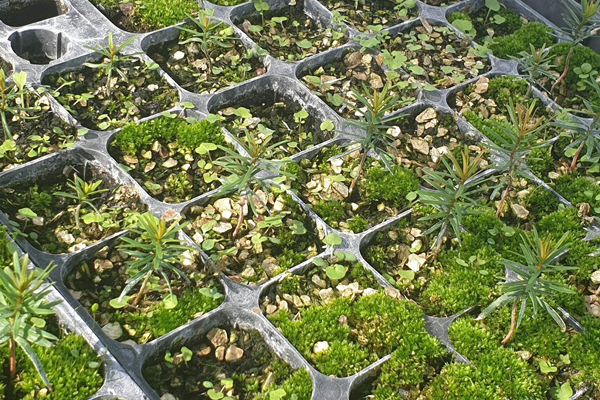
The Central Forestry Nursery (VFC by its Spanish acronym) of the Regional Ministry of Public Works and Environment was involved in the production of quality plants in the Framework of the LIFE BACCATA Project. Their genetic origin was considered based on their genetic characterization carried out at the site where planted and within the LIFE A1 action. Therefore different actions took place in the VFC, ranging from surveying and collecting seed from the region natural yew woods to sowing and producing plants in forestry containers and including pre-treatments on seed germination.
COLLECTING ON-SITE YEW TREE FRUIT
Usually yew tree fruit is manually collected directly from small branches during October and November months. Fruit may also be collected from the forest floor by previously knocking them down with poles or by shaking branches. Collection work can be challenging because this species, apart from growing in inaccessible sites most of times, they alternate bearing and it is necessary to collect fruit from a sufficient number of varied genotypes of each population. Therefore seed was collected from 2016 to 2017 to produce yew seedlings that are implanted in 2019 and 2020. Cuttings were also collected however the difficulties arose in subsequent stages prevented any production from this material.
Usually the collected material (the reddish aryl with seed) is introduced in small cans which are properly identified with double labels to guarantee its traceability and transported to the VFC facilities to be processed.
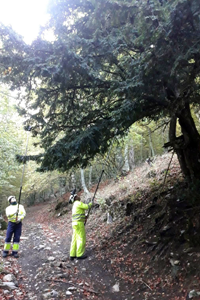

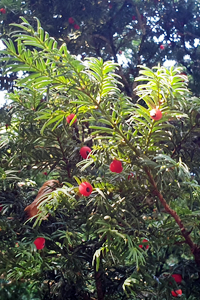
Figure 1, 2 and 3. FRM collected from the forest site.
FRUIT RECEPTION
The forest reproductive material received as fruit at the VFC is temporarily stored in cold rooms at a 3-4ºC / 37-39ºF with a relative humidity of 90% until it is processed.
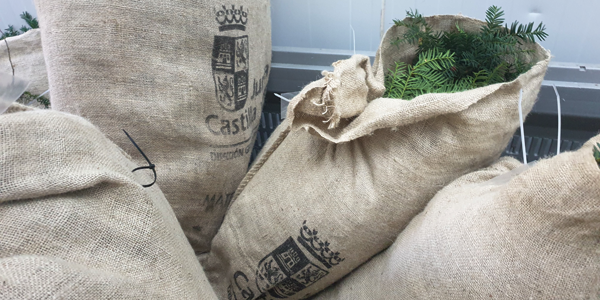 Figures 4 and 5. FMR (fruit and cuttings) delivered to the nursery.
Figures 4 and 5. FMR (fruit and cuttings) delivered to the nursery.
In order to assure the quality and traceability of seeds, batches received should meet different technical and documentary requirements, e.g. bearing identification labels to control its origin, the suitability of packaging that should be properly closed. In addition to these, a visual inspection of the product is carried out to ensure there is no damage by external pathogens.
All batches delivered to the VFC are registered in a database where the related information is entered (e.g. material origin, weight, collection date and date of delivery to the nursery). A single and unchangeable registration number is assigned during the time the material remains in the nursery. Any information gathered from the new accession (shipments, lab test, etc.) will be associated to this number.
SEED EXTRACTION AND CLEANING
Considering seeds and their enveloping fleshy aryl are the most commonly collected material from the forest they are subject to different extraction and cleaning operations until the right seed for use and storage is obtained. This process is aimed at getting the largest amount of cleaned and viable seed.
As far as yew tree concerns, the extraction procedure done by the VFC includes the manual pulp removal to take the aryl apart and some water rinsing. Subsequently water-based decanting, sieving and winnowing processes allow the separation of dead fragments and empty seeds.
Once seeds are cleaned, the material is permanently labelled and then stored in the seed bank.
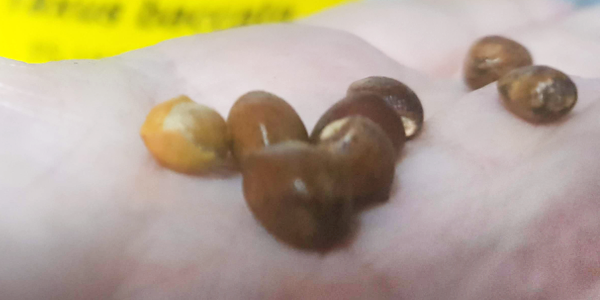 Figure 6. A batch of conserved cleaned seed
Figure 6. A batch of conserved cleaned seed
SEED ANALYSIS AND CONSERVATION
The VFC seed lab is in charge of analysing a representative sample of a seed batch and this task includes the following: Analyses of the moisture content and purity, the specification of 1000 pure seeds, a germination test and a viability study. These tests comply with the ISTA International Rules and are carried out for both, new incoming seeds as well as long-term kept batches that can be used in the future and therefore its evolution may be relevant.
 Figure 7. A germination analysis of a yew seed batch
Figure 7. A germination analysis of a yew seed batch
Suitable conditions should be in place for yew seed preservation so that its viability and germination ability remain the same until it is potentially used. For this reason, it is preserved in the Seed Regional Bank of the VFC which provides several cool rooms equipped with temperature and humidity control (3ºC/37ºF and 60%, respectively).
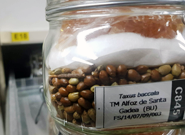 Figure 8. Yew seed batch in germoplasm conservation bank
Figure 8. Yew seed batch in germoplasm conservation bank
PLANT PRODUCTION
Yew plant is usually produced in seed starting trays during spring. This also can be achieved through vegetative propagation from cuttings which results in the production of plant specimens that are identical to each other.
Yew seeds can be very slow to germinate because they have a waterproof coat and deep physiological dormancy and therefore it requires some pre-germination treatments. In line with this, warm-humid stratification for 6-7 months followed by cold-humid stratification for 3-5 months and 1-year stay in the seedbed at a later stage are recommended. Nevertheless, warm-cold stratification cycles are being modified in the VFC to reduce these time frames. Furthermore, attempts are made to avoid the seedbed step providing that pre-germinated seed is available.
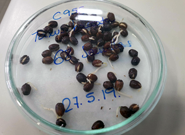 Figure 9. Lab pre-germinating yew seed
Figure 9. Lab pre-germinating yew seed
Following seedbed nascence, seedlings are transplanted into forest containers of 300-400 cm3, which are filled with a mixture of substratum and agri-perlite content. The obtained batches are identified with a registry number and entered in the database.
The objective for the following week is to achieve plants development and acclimation through fertirrigation and plant health monitoring according to each period.
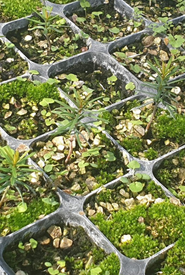

Figure 10. Yew plant in forest container
Figures 11 and 12. Yew plant (with or without plant guard) from seeds at forest site.
Plants are finally used to increase the populations of natural yew woods through forest plantations, which will be accomplished during 2019 and 2020.
REGENERATED YEW TREE TRASLOCATION AND HEALING IN
In parallel to the production of seed-originated FRM in SCAs of Leon Central Mountains where yew regeneration is thriving, translocation and healing in using forest containers took place for their plantation in spring or fall of 2020. Altogether they are approximately 100 seedlings and this way it is expected to complete the production of seed-originated FRM.
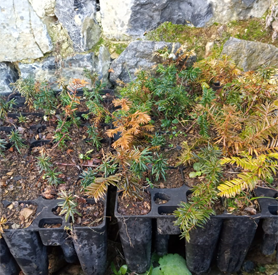
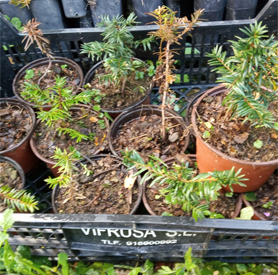
Figures 13 and 14. Seedlings from regenerated yew trees subjected to healing in using forest container and pots.
Usually the collected material (the reddish aryl with seed) is introduced in small cans which are properly identified with double labels to guarantee its traceability and transported to the VFC facilities to be processed.



Figure 1, 2 and 3. FRM collected from the forest site.
FRUIT RECEPTION
The forest reproductive material received as fruit at the VFC is temporarily stored in cold rooms at a 3-4ºC / 37-39ºF with a relative humidity of 90% until it is processed.
 Figures 4 and 5. FMR (fruit and cuttings) delivered to the nursery.
Figures 4 and 5. FMR (fruit and cuttings) delivered to the nursery.In order to assure the quality and traceability of seeds, batches received should meet different technical and documentary requirements, e.g. bearing identification labels to control its origin, the suitability of packaging that should be properly closed. In addition to these, a visual inspection of the product is carried out to ensure there is no damage by external pathogens.
All batches delivered to the VFC are registered in a database where the related information is entered (e.g. material origin, weight, collection date and date of delivery to the nursery). A single and unchangeable registration number is assigned during the time the material remains in the nursery. Any information gathered from the new accession (shipments, lab test, etc.) will be associated to this number.
SEED EXTRACTION AND CLEANING
Considering seeds and their enveloping fleshy aryl are the most commonly collected material from the forest they are subject to different extraction and cleaning operations until the right seed for use and storage is obtained. This process is aimed at getting the largest amount of cleaned and viable seed.
As far as yew tree concerns, the extraction procedure done by the VFC includes the manual pulp removal to take the aryl apart and some water rinsing. Subsequently water-based decanting, sieving and winnowing processes allow the separation of dead fragments and empty seeds.
Once seeds are cleaned, the material is permanently labelled and then stored in the seed bank.
 Figure 6. A batch of conserved cleaned seed
Figure 6. A batch of conserved cleaned seedSEED ANALYSIS AND CONSERVATION
The VFC seed lab is in charge of analysing a representative sample of a seed batch and this task includes the following: Analyses of the moisture content and purity, the specification of 1000 pure seeds, a germination test and a viability study. These tests comply with the ISTA International Rules and are carried out for both, new incoming seeds as well as long-term kept batches that can be used in the future and therefore its evolution may be relevant.
 Figure 7. A germination analysis of a yew seed batch
Figure 7. A germination analysis of a yew seed batchSuitable conditions should be in place for yew seed preservation so that its viability and germination ability remain the same until it is potentially used. For this reason, it is preserved in the Seed Regional Bank of the VFC which provides several cool rooms equipped with temperature and humidity control (3ºC/37ºF and 60%, respectively).
 Figure 8. Yew seed batch in germoplasm conservation bank
Figure 8. Yew seed batch in germoplasm conservation bankPLANT PRODUCTION
Yew plant is usually produced in seed starting trays during spring. This also can be achieved through vegetative propagation from cuttings which results in the production of plant specimens that are identical to each other.
Yew seeds can be very slow to germinate because they have a waterproof coat and deep physiological dormancy and therefore it requires some pre-germination treatments. In line with this, warm-humid stratification for 6-7 months followed by cold-humid stratification for 3-5 months and 1-year stay in the seedbed at a later stage are recommended. Nevertheless, warm-cold stratification cycles are being modified in the VFC to reduce these time frames. Furthermore, attempts are made to avoid the seedbed step providing that pre-germinated seed is available.
 Figure 9. Lab pre-germinating yew seed
Figure 9. Lab pre-germinating yew seedFollowing seedbed nascence, seedlings are transplanted into forest containers of 300-400 cm3, which are filled with a mixture of substratum and agri-perlite content. The obtained batches are identified with a registry number and entered in the database.
The objective for the following week is to achieve plants development and acclimation through fertirrigation and plant health monitoring according to each period.


Figure 10. Yew plant in forest container
Figures 11 and 12. Yew plant (with or without plant guard) from seeds at forest site.
Plants are finally used to increase the populations of natural yew woods through forest plantations, which will be accomplished during 2019 and 2020.
REGENERATED YEW TREE TRASLOCATION AND HEALING IN
In parallel to the production of seed-originated FRM in SCAs of Leon Central Mountains where yew regeneration is thriving, translocation and healing in using forest containers took place for their plantation in spring or fall of 2020. Altogether they are approximately 100 seedlings and this way it is expected to complete the production of seed-originated FRM.


Figures 13 and 14. Seedlings from regenerated yew trees subjected to healing in using forest container and pots.



